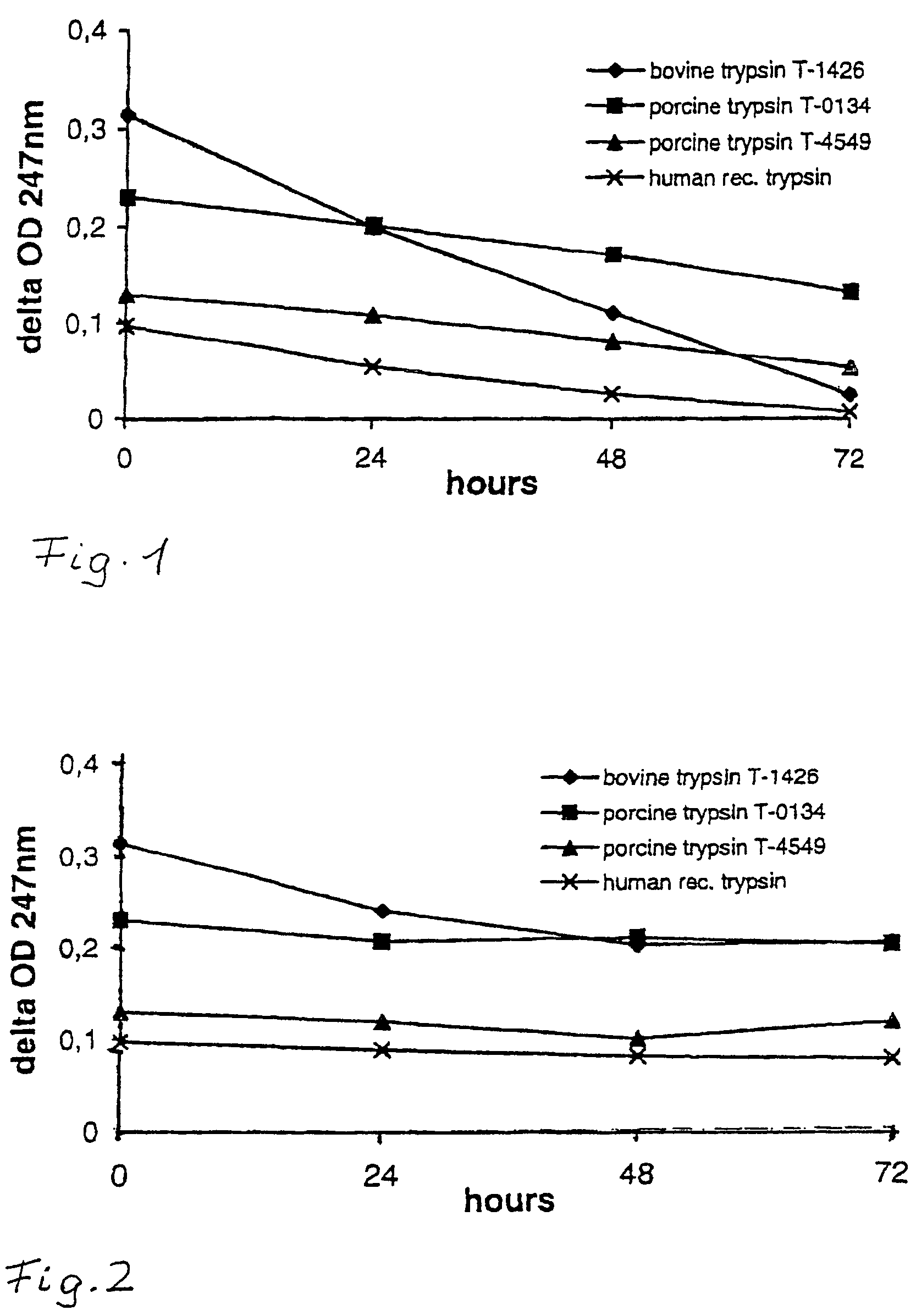Live attenuated influenza vaccine
a technology of attenuated influenza and live vaccine, which is applied in the field of vaccine development, can solve the problems of inability to produce influenza vaccine using embryonated chicken eggs, inability to meet the needs of vaccine production, and reduced immunogenicity, and achieves the effect of simple and efficient process
- Summary
- Abstract
- Description
- Claims
- Application Information
AI Technical Summary
Benefits of technology
Problems solved by technology
Method used
Image
Examples
example 1
Virus Production
[0049]Cultivation of Vero / SF (=serum-free) cells:[0050]SF-Medium: DMEM (Biochrom F0435), Ham's F12 (Biochrom F0815), 5 mM L-Gln, 0.1% SF-supplement (a) or (b); antibiotics (only for first passage of virus isolation).[0051]SF-Supplement: protein hydrolysate of non-animal origin, without functional proteins such as insulin, transferrin or growth factors:[0052]a) 62.5 g hy-soy / UF, Quest 5X59100, to 500 g HQ-water, filtered with PES 0.2 μm filter;[0053]b) 12.5 g hy-pep 1510, Quest, to 100 g HQ-water, filtered with PES 0.2 μm filter.
[0054]The content of a deep frozen (liquid nitrogen) disinfected (70% ethanol) ampule of WCB Vero cells was thawed and added to 9 ml of cold serum-free (SF) medium in a 10 ml tube and centrifuged for 10 min at 1000 rpm (170 g). The pellet was resuspended in SF-medium to a total of 30 ml, transferred to a 80 cm2 Roux bottle and incubated at 37° C. and 7% CO2 for at least 15 min. Thereafter, the medium was removed and the cells were washed with ...
example 2
Comparison of Trypsin Inactivation in Cell Cultures
[0058]
TABLE 1Trypsin inactivation in Vero vs. MDCK cell cultureVero / MDCK0 h24 h48 h72 hbovine trypsin0.314 / 0.3140.199 / 0.2390.110 / 0.2010.026 / 0.203porcine trypsin0.230 / 0.2300.201 / 0.2060.171 / 0.2090.133 / 0.201(high)porcine trypsin0.129 / 0.1290.108 / 0.1180.081 / 0.0990.054 / 0.116(low)human rec0.097 / 0.0970.054 / 0.0880.026 / 0.0800.008 / 0.076trypsin
[0059]Supernatants obtained from uninfected Vero cell cultures (grown in SF medium as described in Example 1) and MDCK cell cultures (grown in FCS-supplemented medium as described in Example 1) were tested for their capacity to inactivate trypsin of different origin that has been added to the supernatant at time =0 h at equal concentrations each. Porcine trypsin has been applied in two different qualities (obtained from different manufacturers), i.e. with high or low activity. The results are presented in Table 1 and in FIGS. 1 and 2.
[0060]The data unambiguously show that bovine trypsin is rapdily inactiv...
example 3
Comparison of Various Viral Properties After Growth on Different Host Cell Substrates
[0061]Virus propagation was carried out as described in Example 1 for the different host cell substrates. Each of the seven isolates recovered on Vero cells was reactive with human erythrocytes but not with chicken erythrocytes and none of them accumulated in embryonated eggs. On the other hand, all isolates recovered on MDCK cells were reactive both with chicken and human erythrocytes and were capable of growing in eggs. Although these differences were not seen in influenza A viruses of the H1N1 substype nor in influenza B isolates (see subsequent Tables 3 and 4), it may nevertheless be assumed that cultivation of influenza viruses on Vero cells will maintain antigenic properties more properly than cultivation on other substrates.
[0062]
TABLE 2Characteristics of H3N2 viruses isolated from clinical material onVero / SF cellsHA titer withIsolateAntigenicallyIsolatedchickenhumanGrowth innumberrelated too...
PUM
| Property | Measurement | Unit |
|---|---|---|
| Temperature | aaaaa | aaaaa |
| Temperature | aaaaa | aaaaa |
| Temperature | aaaaa | aaaaa |
Abstract
Description
Claims
Application Information
 Login to View More
Login to View More - R&D
- Intellectual Property
- Life Sciences
- Materials
- Tech Scout
- Unparalleled Data Quality
- Higher Quality Content
- 60% Fewer Hallucinations
Browse by: Latest US Patents, China's latest patents, Technical Efficacy Thesaurus, Application Domain, Technology Topic, Popular Technical Reports.
© 2025 PatSnap. All rights reserved.Legal|Privacy policy|Modern Slavery Act Transparency Statement|Sitemap|About US| Contact US: help@patsnap.com



